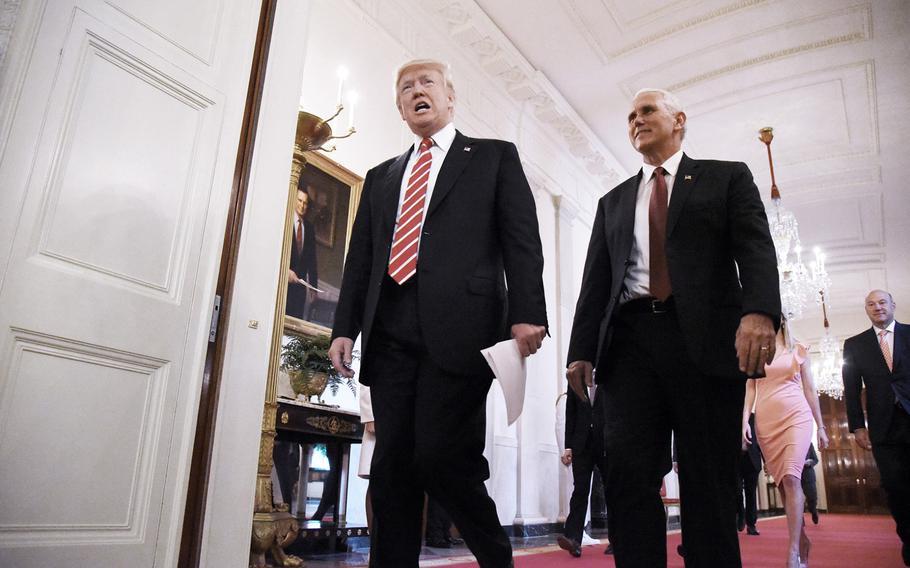
President Donald Trump and Vice President Mike Pence arrive in the East Room of the White House on June 22, 2017, in Washington, D.C. (Olivier Douliery/Abaca Press/TNS)
WASHINGTON – President Donald Trump on Tuesday directed the Pentagon to establish a new combatant command charged with overseeing all of the U.S. military’s space operations across all of its branches.
Trump ordered the formation of U.S. Space Command, a four-star unified command to lead military space operations and develop the Pentagon’s space warfighting plans and techniques, in a directive sent to the Defense Department. Pentagon officials said they would immediately work to build the new command, the department’s 11th combatant command.
In his order, Trump charged Defense Secretary Jim Mattis to recommend leaders for Space Command. Pentagon officials said they expected such recommendations to be made within “the next several weeks,” but they declined to provide names of flag officers under consideration.
“The [Defense] Department will move expeditiously to establish U.S. Space Command once a commander is appointed,” said Army Lt. Col. Joe Buccino, a Pentagon spokesman.
Pentagon officials have yet to determine where Space Command will be headquartered or how quickly the new command will be fully operational, he said.
The directive had long been expected. While some lawmakers have pushed back against Trump’s plans to build a Space Force, a sixth branch of the military, Pentagon officials, including Mattis, have long championed the establishment of a combatant command focused on space, especially as competitor nations have advanced their own space capabilities and shown interest in using them for military purposes. For example, China has recently displayed the ability to hit satellites with missiles and Russia has vowed to develop space-based laser weaponry.
Vice President Mike Pence, in a speech Tuesday morning from the Kennedy Space Center in Cape Canaveral, Fla., declared “a new era of American national security in space.”
He said Trump would soon sign a new space policy directive in which the administration would lay out its plans for building a Space Force. While establishing Space Command does not require congressional legislation, lawmakers would have to approve the formation of a new military branch.
“We’re working as we speak with leaders of both parties in Congress to stand up the United States Space Force by the end of 2020,” Pence told airmen with the 45th Space Wing, based at Patrick Air Force Base and Cape Canaveral Air Force Station.
The military has about 18,000 servicemembers and civilians working on space operations. While the Air Force has responsibility for the vast majority of the Pentagon’s space operations – including operating 77 of the military’s more than 100 satellites – all five branches have space programs.
It remains unclear whether the Space Force would be a fully independent branch of the military, such as the Army and Air Force, or it would take on a form similar to the Marine Corps, which is part of the Navy Department. Pentagon officials have said they’ve looked at both options, including placing it within the Air Force. Ultimately, that decision would be up to Congress.
Deputy Defense Secretary Patrick Shanahan, in a series of tweets Tuesday, said the Pentagon was already working with Congress to develop plans for Space Force.
He wrote Space Force and Space Command will have relationships to the military services like the services now have with the four other functional combatant commands – U.S. Cyber Command, U.S. Strategic Command, U.S. Transportation Command and U.S. Special Operations Command.
“The Space Force will serve as a force provider for personnel, assets, and capabilities supporting space operations while Space Command will serve as the operational command that will employ space capabilities and lead space operations,” Shanahan wrote on Twitter.
Pentagon and White House officials have not said how many personnel would be assigned to a Space Force nor have they provided detailed cost estimates.
In September, Air Force Secretary Heather Wilson estimated establishing the new military branch could cost up to $13 billion. However, Shanahan told reporters last month that it would cost much less, saying he believed Space Force could be established at a cost below $5 billion.
dickstein.corey@stripes.com Twitter: @CDicksteinDC